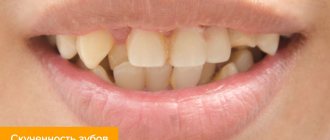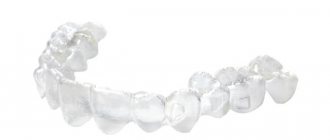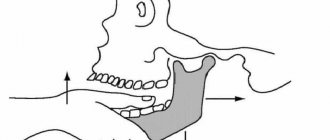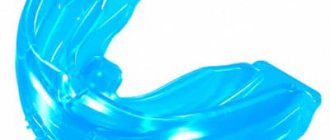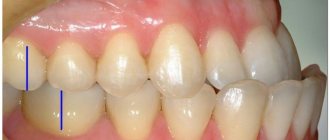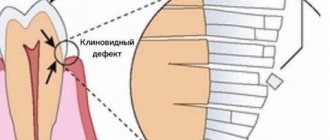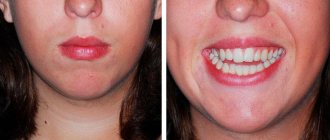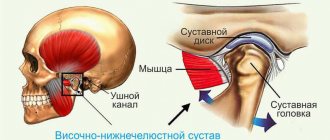Problem: a young man was referred to orthodontist O.A. Baranova by an orthopedic dentist. The patient was concerned about the absence of a canine in the upper jaw on the right, a shift in the center of the upper jaw to the right (the white line in the photo shows the center of the jaw), protrusion of the lower teeth, and crooked growing teeth.
Solution: the bite was corrected using the Damon brace system, a place was prepared for high-quality prosthetics, which is necessary to secure the correct bite.
Symptoms accompanying mobility
In fact, there is only one symptom - when you touch a tooth with your finger, tongue or any object, as well as during eating, its mobility is clearly felt. As a rule, horizontally, that is, a shift to the right-left or forward-backward. Other symptoms are mainly associated with the underlying disease and, as a rule, we are talking about inflammation of the gums, exposure of the roots, the formation of copious amounts of deposits under the soft mucous membranes, even rotting of the contents of periodontal pockets.
Observation after dental prosthetics
The doctors took the situation under observation and met with the patient a few months after the completion of dental prosthetics. It was clear that the movement of the teeth continued. The result got worse. The lower front teeth have moved further apart and shifted. Aesthetics were lost, gaps appeared between the teeth, where tartar immediately began to form, and the gums became inflamed.
Type of teeth during observation:
Ultimately, we saw this picture - gaps between the teeth:
At Family Dentistry, we work with complex cases and provide support to patients throughout their lives and beyond.
We began to understand the reasons for the possible movement of teeth. Most dentists believe that they work with immobile teeth. But some very good specialists know that the teeth and bones of the skull are not motionless. And only a few good dentists know that teeth are immobile and know how to work with it.
Causes of mobility
There are quite a few reasons that cause abnormal mobility. The main ones are the following:
- age-related changes, hormonal imbalances,
- lack of vitamins and minerals,
- inflammatory processes of the gums, i.e. diseases of periodontal tissues – periodontitis and periodontal disease. These are the main reasons why teeth begin to become loose. In turn, their development is caused by poor oral hygiene,
- the presence of gaps in the row, as the teeth begin to shift towards the empty space,
- injury to the jaw system or the tooth itself, its root,
- complications of chronic diseases associated with disruption of the endocrine or immune system,
- purposeful loosening of the tooth,
- incorrect bite, as well as uneven pressure on one or a group of elements of the dentition.
Timely identification of the cause of the problem will allow you to save your teeth by restoring the functionality of the ligamentous apparatus and jaw bone cells.
Background - total dental prosthetics
Doctors at the Family Dentistry performed very complex work on dental prosthetics with ceramic crowns, some of which were installed on dental implants (read more about this work here). Total prosthetics was performed - all 28 of the patient’s teeth were restored with ceramics. At the same time, the bite, facial proportions, length and inclination of the teeth were changed. Which, accordingly, required adaptation of the patient’s neuromuscular system to new conditions. The temporomandibular joints, the muscles of the lips and tongue, and the muscles that move the lower jaw and neck had to accept the new teeth and adjust to working with them. Usually such adaptation occurs without problems within a short period of time. But in some cases, muscle tone and a certain activity inherent in the muscles before prosthetics remain after prosthetics and spoil the achieved result.
Compare the situation before and after prosthetics using the most modern Astra Tech dental implants and the most modern E.max restorative ceramics:
The excellent results of prosthetics are obvious. But almost immediately after dental prosthetics, the attending physician Tsukor S.V. I noticed a trend - the lower front teeth have moved slightly apart. At the same time, the position of the remaining teeth remained stable.
What options are there for straightening the front teeth?
Bite correction in adults can be done using braces or aligners. Many people think that they wear braces when they are young, but when they become adults, it is not respectable. There is a logic to this, which is why many people choose aligner systems that are invisible to prying eyes. Like, for example, this man
Women are worried about wearing braces because of much greater inconveniences: from psychological to aesthetic. For example, this girl has experienced psychological discomfort with braces since childhood: The question of which bite correction system to choose relates to the individual choice of each patient. There are many selection criteria, one of them is price. But aligners have a huge advantage - the aesthetics of the treatment.
Smile aesthetics - the beauty of the front teeth
A beautiful smile is very aesthetic in itself. And also due to the fact that women take care of their teeth. Dental aesthetics are perhaps the main indicator of a smile. Regardless of age, we automatically examine the teeth of our interlocutor. It’s the front teeth, they’re visible. Why are we considering it? This is the nature of our relationships. And in the next video, the heroine acutely understands this problem, although she is still very young - but she has some violations of the aesthetics of her teeth, which, by the way, appeared precisely because of the movement of the figure eights. And thanks to the invisible aligners, the problem will go away in a few months.
Remember about the "eights" and - a beautiful smile to everyone!
Yours, Tatyana Gevorkyan
Why is there a problem?
Among the reasons causing loose teeth:
- Periodontitis. With this disease, even healthy canines, molars and incisors lose their former stability in the socket. Other characteristic symptoms of the disease are the appearance of bad breath and bleeding gums.
- Periodontal disease. A diagnosis in which atrophy of the jaw bone tissue is detected. The gums become inflamed, red, and swollen. This subsequently leads to loosening of individual units.
- Periodontitis. A condition that affects the roots of teeth. It is in them that the destructive process begins. The pathology is very insidious and, in the absence of adequate therapeutic measures, leads to the need to remove a loose tooth.
- Flux or periostitis of the gums. It manifests itself as an accumulation of purulent masses in the tissues of the periosteum. For this reason, the roots lose their ability to be firmly held in hard tissues, the hermetic contact is broken - loosening occurs.
- Cyst. A fairly common dental problem. Affects the area adjacent to the root. If drug correction does not provide positive dynamics, the surgical method is used. An advanced cyst affects a large area of the jaw, which has a bad effect on the stability of teeth and the well-being of a person in general.
- Granuloma. Inflammatory formation at the apex of the tooth root. In fact, this is an advanced and complicated cyst. The disease has the following symptoms: unsteadiness of individual units, sore gums, swelling, decreased overall performance.
Prevention of periodontitis
To prevent periodontitis, the patient is recommended to undergo professional teeth cleaning twice a year. If plaque forms on your teeth quickly, or you have problems with self-hygiene, then it is better to visit a hygienist more often, this will preserve the health of both your teeth and gums. Read more about prevention and hygiene measures here.
The patient took a break for some time to prepare financially for further treatment. Doctors did everything to maintain the health of the dental system while waiting.
Types of dystopia
Abnormal arrangement of primary teeth is rare; usually permanent teeth are susceptible to dystopia. They can be dystopic within the dentition or outside it, they can be deployed along a vertical axis, and have different inclinations. Depending on the position of the tooth, the following types of dystopia are distinguished:
- Vestibular - the tooth moves outward from the dentition to the vestibule of the oral cavity. Most often, incisors and canines are affected by this type of deviation. A person’s smile with dystopic fangs is commonly called a “vampire smile.”
- Mesial – the tooth moves forward along the dentition.
- Distal – deviation of the tooth back along the dentition.
- Oral: Lingual deviation – a tooth on the lower jaw is displaced towards the tongue. It is observed more often on incisors and premolars.
- Palatal deviation - a tooth on the upper jaw is shifted towards the palate. This dystopia is typical for central incisors.
- Supraposition - the lower jaw tooth is displaced vertically above the occlusal curve (the line that passes through the points of closure of the teeth).
Dystopia of impacted teeth, that is, unerupted teeth, is also diagnosed. Often this anomaly is characteristic of the third molars (wisdom teeth): they are located horizontally or obliquely in the jaw bone or in the gum tissue.
Sometimes an anomaly occurs such as dystopic supernumerary teeth - additional teeth that erupt outside the dental arch (in the palate, on the gums).
Treatment of tooth canals under a microscope
To eliminate inflammation at the roots of the two front teeth, dental canal treatment was performed under a microscope. The significant magnification provided by the microscope helps to thoroughly clean the canals of the teeth and not miss the branches and bends of the canals. Thanks to the professionalism of the endodontist and excellent equipment, the infection in the canals, which causes inflammation at the roots, is completely eliminated.
After dental treatment under a microscope, the canals are hermetically sealed and the bone at the roots is restored. Treatment under a microscope saves teeth from removal.
Bottom line
Do not panic if your lower tooth has moved forward or backward - in order to avoid complications, it is recommended not to ignore the current situation and consult a doctor. Only an experienced specialist who knows modern diagnostic and therapeutic techniques for solving such problems can develop optimal tactics for restoring a displaced element. In most cases, doctors manage to restore a beautiful smile to patients even with an initially difficult clinical picture.
Basic types of offset:
- Mesial displacement - the tooth is located in front of its natural position in the jaw arch.
- Distal displacement - the tooth moves back from its optimal position in the jaw row.
- Vestibular displacement - most often the anomaly affects the fangs, the teeth move towards the vestibule of the oral cavity.
- Oral displacement - classified into lingual and palatal.
- Palatal anomaly is characterized by movement of the elements of the upper jaw towards the palate.
Peculiarities
Dental crowding is a pathology characterized by:
- incorrect angle of rotation of some teeth relative to the rest (tortoanomaly),
- vestibular (outward) or palatal (inward) inclination of the teeth,
- “pile up” of teeth, their position is too close,
- eruption of teeth outside the dental arch due to lack of space in the dentition.
Depending on the severity, crowding of teeth can be:
- mild - crowding on one jaw is about 2-3 mm, no more than 2-3 teeth are crooked;
- medium - the displacement reaches 4-65mm;
- severe - more than 6 mm, many teeth are displaced, which is clearly visible to others;
- very severe - the lack of space in the dental arch reaches 7-8 mm, the position of all or almost all teeth is disturbed.
Diagnostics
Diagnosis of dystopic teeth consists of examining the oral cavity, assessing the bite and obtaining x-ray data. To accurately determine the condition of teeth and jaws, use:
- Teleradiography - X-ray examination is carried out from a large focal length, which reduces the radiation dose to the patient and reduces distortions in the image. Teleradiography is needed not only for diagnostics, but also for predicting the results of treatment and monitoring its process.
- Computed tomography is a layer-by-layer study of tissue. The images are combined into a 3D image, which allows you to more accurately study the position of the tooth in the jaw and develop a treatment plan.
- Orthopantomography - provides a detailed image of the jaw and all teeth, allows you to evaluate the inclination of erupted and impacted teeth, and detect anomalies of tooth germs and hard tissues.
Content:
- Why is there a problem?
- Other reasons
- Is it necessary to remove a loose tooth?
- How to save a loose tooth
Only children with primary occlusion can react calmly to a loose tooth. For everyone else, this is a serious problem that requires immediate dental attention. If measures are not taken in time, you may encounter partial edentia - the movable unit will simply fall out at some point, which will negatively affect the functioning of the maxillofacial apparatus and, of course, the appearance of the smile. You should not decide on your own whether to remove a loose tooth. Only a qualified dentist, after an in-person examination, can tell you what to do correctly in a particular situation. Today, thanks to a large number of innovative treatment techniques, doctors most often manage to save even loose units.
Teeth straightening with aligners
Re-prosthetics in this situation would be very expensive, since it would be necessary to replace 4 ceramic crowns on the lower front teeth. This method is quick but expensive and does not truly move the roots. By replacing the crowns, we seem to mask the situation. In the end, a different decision was made!
Using the most modern computer developments from the 3DSmile company, we have produced special mouth guards for the lower jaw. Mouth guards for straightening and moving teeth according to a given program. The mouthguards are hard. Each aligner is programmed with minimal tooth movement. Each mouthguard must be worn for 2 weeks. Analysis using special software showed that in order to set the teeth back, remove the gaps between them and return the teeth to the correct position, eight aligners are needed, which must be worn sequentially one after another.
Type of mouthguard on teeth:
The trays on the teeth are almost invisible. They must be worn 23 hours a day. But for meals and in emergency situations, the mouth guard can be removed. This creates additional convenience for the patient.
Alignment with aligners returned the original treatment result!
View of teeth at the beginning of treatment with aligners and after treatment with 3DSmile aligners:
Tooth extraction under sedation
Some teeth could not be treated. Removal of failing teeth was even necessary to stop the inflammatory process and bone loss.
Tooth extraction under sedation relieves stress and increased blood pressure. The patient is in a state of medical sleep while the teeth are removed and sutures are applied, and after the operation he quickly comes to his senses, without unpleasant memories. The operation lasted 1 hour.
Two weeks after the teeth were removed, the condition of the gums improved noticeably.
What are the dangers of abnormal tooth position?
In addition to the fact that dystopic teeth spoil the beauty of a smile, they can cause:
- traumatic (decubital) ulcers of the mucous membranes of the oral cavity, which can degenerate into malignant neoplasms;
- glossitis - inflammation of the tongue;
- pain when chewing;
- disruption of eruption and displacement of adjacent teeth;
- malocclusion, disorder of chewing function and, as a consequence, deterioration of the gastrointestinal tract;
- accumulation of dental plaque, deposition of tartar on dystopic and adjacent teeth due to the difficulty of hygiene; as a result – the development of caries and its complications;
- speech disorder.
Dystopic impacted wisdom teeth cause:
- pain in the jaw, increasing when opening the mouth, chewing and swallowing;
- headaches;
- increased body temperature;
- swelling of the gums and tongue;
- trigeminal neuralgia;
- inflammation of the submandibular lymph nodes;
- destruction of a nearby tooth;
- pericoronitis - purulent inflammation of the gums during partial tooth eruption.
A retromolar cyst often appears at the apex of the root of a dystopic wisdom tooth, which threatens the development of odontogenic sinusitis and the spread of infection to other organs through the circulatory system.



